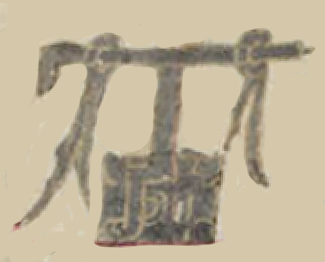tepoztlatlapoloni (CST12)
This painting of the simplex glyph for the term tepoztlatlapoloni (metal key), which is seemingly shown here as a metal locking device with two keys hanging from a bar. This is all shown in a frontal view. The companion text explains that these items were needed in the home (storage place?) of the silk, which would have been raised locally but introduced by Europeans, along with these metal objects.
Stephanie Wood
This technology was introduced in the process of the Spanish colonization of Mexico. For other examples of similar metal objects, see the tepoztli entry from Plate 2 of the Codex Sierra-Texupan. And, generally, for more on the Codex Sierra, see Kevin Terraciano’s study (2021).
Stephanie Wood
1550–1564
Jeff Haskett-Wood
metales, llaves, cerraduras, bodega para seda
These forged iron “chapas de puertas” as they are called museum signage come from the first half of the seventeenth century. They are more elaborate door fixtures than the one in the glyph above. These have iconography of heraldry, such as the Habsburg double-headed eagle. Museum of the city of Guadalajara. Photo by S. Wood, 15 April 2025.

tlatlapoloni, key, https://nahuatl.wired-humanities.org/content/tlatlapoloni
tepoz(tli), copper or metal, https://nahuatl.wired-humanities.org/content/tepoztli
llaves de metálicas
Stephanie Wood
Códice Sierra-Texupan, plate 12, page dated [1]554. Origin: Santa Catalina Texupan, Mixteca Alta, State of Oaxaca. Kevin Terraciano has published an outstanding study of this manuscript (Codex Sierra, 2021), and in his book he refers to alphabetic and “pictorial” writing, not hieroglyphic writing. We are still counting some of the imagery from this source as hieroglyphic writing, but we are also including examples of “iconography” where the images verge on European style illustrations or scenes showing activities. We have this iconography category so that such images can be fruitfully compared with hieroglyphs. Hieroglyphic writing was evolving as a result of the influence of European illustrations, and even alphabetic writing impacted it.
https://bidilaf.buap.mx/objeto.xql?id=48281&busqueda=Texupan&action=sear...
The Biblioteca Digital Lafragua of the Biblioteca Histórica José María Lafragua in Puebla, Mexico, publishes this Códice Sierra-Texupan, 1550–1564 (62pp., 30.7 x 21.8 cm.), referring to it as being in the “Public Domain.” This image is published here under a Creative Commons license, asking that you cite the Biblioteca Digital Lafragua and this Visual Lexicon of Aztec Hieroglyphs.


